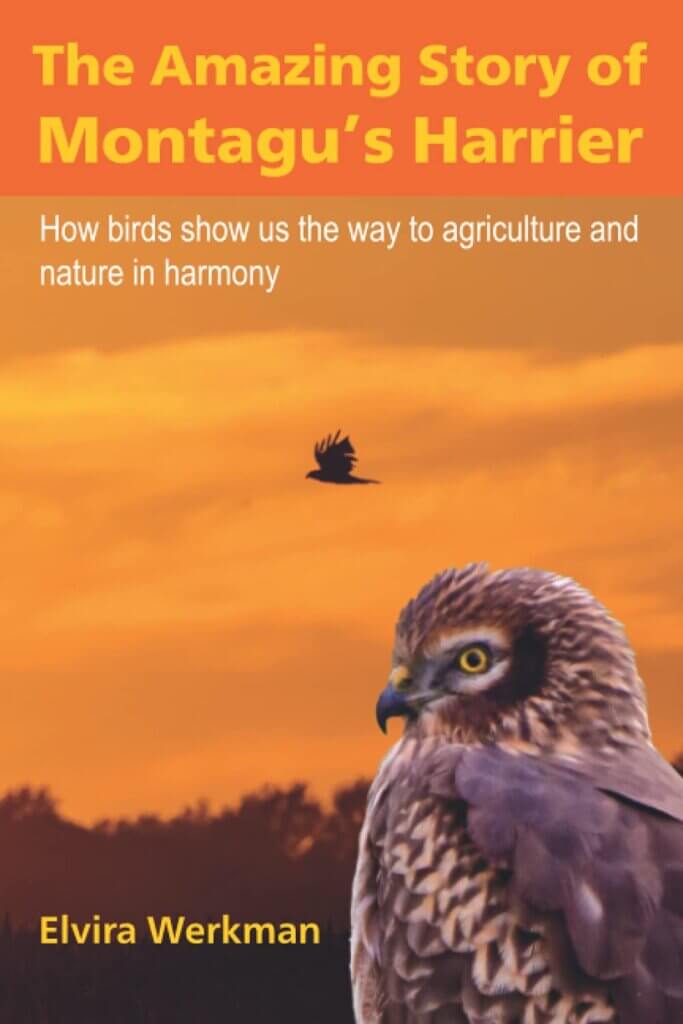
This is a fine book which I have enjoyed reading on my travels over the last few weeks. I knew I’d find it interesting because it deals with a couple of subjects which are really interesting scientifically and in terms of nature conservation; how wildlife fits in with modern agriculture and which part of a migratory species’s annual cycle is really the pinchpoint in its population dynamics? And it explores them through the lens of harriers, mostly Montagu’s Harriers but other harriers, most interestingly Pallid Harriers, but Hen and Marsh Harriers get plenty of mentions too.
And, although the heroes of the book are largely the birds, much of the work described was instigated by a Dutch guy called Ben Koks so he is the main human protagonist of this book. Ben stayed with me for a few days over the 2019 Bird Fair and I like his company very much.
This is largely the story of Montagu’s Harriers in the intensively-farmed country of the Netherlands. The birds aren’t doing stunningly well but with the help of conservationists, and farmers, they are doing far better than they otherwise would, they haven’t disappeared as was expected and predicted, and they are much more numerous than they are in the farmland of the UK. There are lots of accounts of how farmers react to wildlife and they sound familiar – some love it, some ignore it and some grow to like it a bit more with some coaxing. The quotes from the agricultural community ring true and demonstrate accurately the pleasures and frustrations of working with that industry.
Montagu’s Harriers travel to the Sahel zone of Africa in our winter – is it conditions there that determine their numbers, or back here on the breeding grounds, or at stopover points on the long migrations hither and thither, or bits of all of those things? Well, it’s difficult to be sure but it’s even more difficult if you never leave Europe, and this book has plenty of evidence, insights and great stories about the places that Montagu’s Harriers visit in a full 12-month period. Grasshopper counts, harrier roost counts and pellet analysis in Africa might get us a better understanding than speculating from the adjacent continent but it’s not easy to get to such answers, although it is challenging, important and fun to try. Walking a transect with two men carrying Kalashnikovs accompanying you might be a bit different from most people’s picture of fieldwork.
There was a lot of really interesting information about the birds in these pages. Just as a trivial example, the discussion about why harriers often roost together was fascinating but not remotely conclusive. Three Montagu’s Harrier roosts close to each other in the Khelcom region of Senegal probably hold a quarter of all Senegal’s wintering Montagu’s Harriers – 6000 of c25,000 birds. Wow! I was fascinated to read that Montagu’s Harriers often leave their roosts, en masse, well after dark, and change to a different locality. I wonder whether I could borrow an infra-red camera to watch the Hen Harrier roosts at Wicken Fen this winter?
There is a short but very useful chapter on Pallid Harriers too – are they heading to western Europe – it seems they are? Is this because they are being pushed out of Eastern Europe by habitat change – maybe? How are they doing on the steppes of Kazakhstan – not so well? Will they interbreed with Montagu’s and Hen Harriers – they might?
Many people have contributed to our growing understanding of smaller harriers and they are given prominence in this book, but Ben Koks has clearly been an encourager, a provocateur and an important link in chains between researchers, conservationists and farmers. Ben, from my brief knowledge of him, is a people-person and I think he now owes me a good bottle of wine, but when we eventually meet up to drink it, one won’t be enough – there will be so much to talk about.
This book was originally written in Dutch and the translation is almost perfect – it actually reads like a Dutchperson’s almost perfect use of English. The photographs inside the book are a bit dull and the title is a mouthful but the cover is rather nice – I’d give it 7/10 and then upgrade it to 8/10 because it’s a harrier.
This is a fine book.
The Amazing Story of Montagu’s Harrier: how birds show us the way to agriculture and nature in harmony by Elvira Werkman is published by the author.
[registration_form]
Sounds a really worthwhile read probably a “must” read.
Wonder if those self proclaimed conservationists have / will read it?
Not read it yet buy based on Mark’s review I wonder if maybe it should be compulsory reading for defra Ministers & staff?